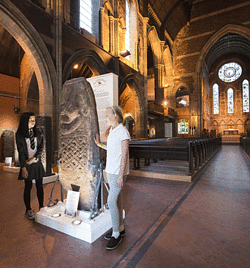We have confirmed two excursions for the 2014 conference, with kind support from University of Glasgow Archaeology and from Historic Scotland. You can book to go on one - or both - of the tours on the conference booking form, or by indicating you would like to book when you request a paypal invoice when booking online.
FR3 A visit to the Antonine wall (No more bookings being taken - please enquire at the conference registration desk upon arrival)
On Thursday afternoon delegates will have the option of travelling to see part of the Antonine Wall, with a pop-up exhibition on board the coach provided by the Hunterian Museum.
Professor Bill Hanson will guide a trip to the Antonine Wall fort at Bar Hill where a pot kiln was recovered from the bath house furnace and a wealth of artefacts deliberately thrown down a well. Then on to Rough Castle fort where the best surviving section of the Antonine Wall is extant. The Hunterian Museum will also be providing a pop-up museum of Roman artefacts from the excavations on the trip and delegates will also see the Falkirk wheel.
FR4 Glasgow Cathedral & Govan Stones (No more bookings being taken - please enquire at the conference registration desk upon arrival)

On Friday morning, Steve Driscoll and Adrian Cox will accompany delegates to Glasgow Cathedral, discussing both the building and the archaeological excavations, after which the tour will continue to see the Govan Stones.
The trip will explore the city's two most important ecclesiastical sites. St Kentigern's (aka St Mungo's) is the only cathedral in Scotland to have come through the Reformation intact on the Scottish mainland. The core of the building dates to the 13th century and is an exceptionally pure example of the Gothic idiom. The crypt is arguably the finest in Britain. In the 1990s excavations by Steve Driscoll revealed traces of two earlier cathedrals and an earlier cemetery.
Govan Old houses a remarkable collection of early medieval sculpture (9th-11th C) which derives from the time when it was the principal church of the Kingdom of Strathclyde. The collection which includes the largest group of hogback stones in Scotland has clear Norse influences. Excavations by S Driscoll in the 1990s revealed a cemetery going back to the 5th/6th century. The sculpture (http://www.thegovanstones.org.uk/) has recently been redisplayed within the Gothic Revival church.


